Learning how to fingerpick your acoustic guitar opens up a whole new world of possibilities for your playing. The things you can do multiply drastically when using a fingerpicking approach.
However a common problem when someone is learning how to fingerpick their guitar, is they go with what feels "easy" to them as opposed to what is "right".
Going with what feels easy will only lead you down the path of incorrect, inefficient, and problematic technique for fingerpicking your acoustic guitar. This sets up a very weak foundation for all your fingerpicking playing and will severely limit what you can do with the technique in the songs that you want to play or write on your guitar into the future.
I know this from personal experience, as I went with a very much trial and error approach when first trying to fingerpick my guitar. It was both time consuming and frustrating to say the very least. Frustrating because I would put so much time into the technique for very little return.
Don't do what I did, because every hour spent reinforcing bad fingerpicking technique, there is an hour needed to correct it and start building a strong foundation on which to play the stuff you want to be able to play. You might as well just go about it the right way in the first place.
But what is the "right'" fingerpicking technique and how can you be sure to avoid going with what feels "easy". Well I'm glad you asked because that is what the remainder of this article will address for you, in detail, so you can clearly define "right" from "easy" when learning how to fingerpick your acoustic guitar.
If you have fingerpicked your guitar before, even if you are quite experienced at it, I strongly suggest you still read this article. As the saying goes "you can never step into the same river twice", meaning you are a different, more evolved player each time you revisit, refine, and improve a particular technique. Fingerpicking is no different, so let's get to it!
Let's look at the easy way to fingerpick your acoustic first. I define easy by going with what ever comes naturally to you when exploring this technique and there are 3 main problems that occur when going this route.
Going the easy way almost always leads to poor finger choice when fingerpicking your guitar. Poor finger choice could be defined as using whatever finger feels comfortable to you at the time to pick the strings, and in turn will lead to very inefficient movements which leads to bad fingerpicking technique and you not sounding any good on your guitar.
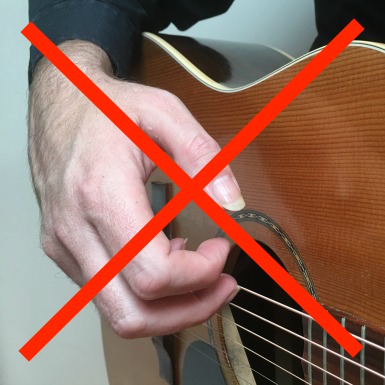
This is a classic case of going with what feels easy. It is very unlikely that choosing whatever fingers feel comfortable to you in the beginning, just happens to be the right finger choice too. Don't leave it to chance!
Another symptom of going with what feels easy is the position of your picking hand and the angle of your fingers to the strings. Get this wrong and it won't even matter if you are using the correct fingers to pick your strings or not. This is because your fingers will be approaching the strings from the wrong angle, resulting in you not getting the leverage needed to pluck the string effectively. Again, this severely limits your fingerpicking technique.
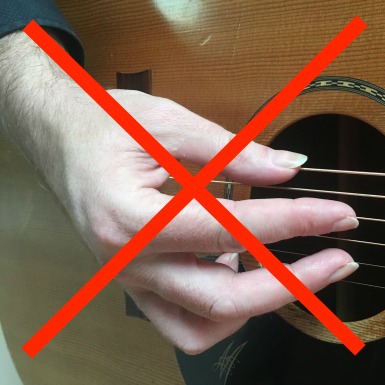
I see this particular issue with a lot of fingerpickers, and while you will still get sound from plucking the strings this way, you will be attacking the strings from a position of weakness.
Don't let your hand/arm you are using to fingerpick itself have inefficient movements. In fact, if your arm has any movement at all it's a big problem and will certainly get in the way of you and a great technique for fingerpicking your guitar.
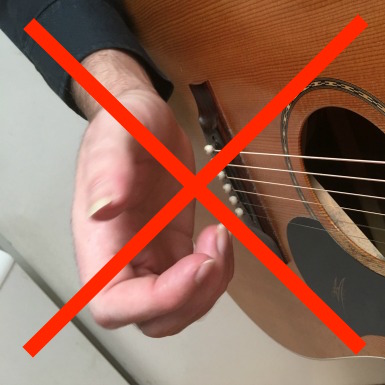
Another symptom if you take a DIY approach to fingerpicking your guitar.
Now, there may be times when going with what feels easy and natural to you when playing something on the guitar also happens to result in the right way to go about it. However over many years of teaching many people how to play guitar, I have found that if something feels easy or natural to you when you first try it, then there is a more than fair chance that it is also the wrong way to go about it.
Think about watching someone attempt to play guitar for the first time using only one finger to fret notes. Sure it feels easier, but it certainly isn't the right way to go about it. You need to make sure that you don't do the equivalent with your fingerpicking technique.
So then, what is the right way to fingerpick your guitar?
Well, truth be known, there actually isn't one right way to fingerpick your guitar. If you study the playing of great fingerpickers such as Tommy Emmanuel or Martin Taylor for example, you will find differences in how they go about fingerpicking their guitars, however what will be the same are the fundamentals that create the foundation for their jaw dropping skills.
And that is the point, get the fundamentals right with your fingerpicking and the rest will take care of itself.
Before we take a closer look at these fundamental areas of great fingerpicking technique, it's worth mentioning that it's recommended you have long enough fingernails on your picking hand so that when you pluck the strings they contribute to the sound.
I'd say its approximately a 60/40 ratio of nail to flesh that strikes the string. You need to file your nails so they are rounded and make sure they are not too long as they will get caught under the string when plucking.
Can you fingerpick without any nails? Yes, but I'd suggest you go the nail approach as you will have more control and a better tone to your sound.
So let's look at the fundamental areas of fingerpicking by addressing the 3 main problems we outlined above, that are all symptoms of taking the easy way over the right way.
Here is a guide for you to follow to start building a strong fingerpicking foundation for your acoustic playing:
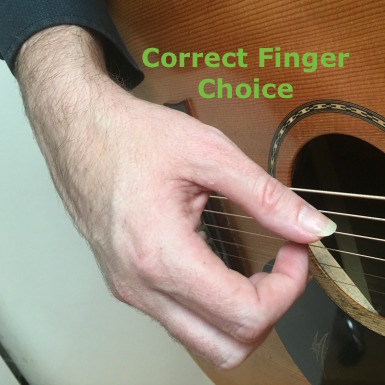
- Thumb (p) plays notes on the lower 3 bass strings of your guitar (ie. the E, A, and D strings).
- Index finger (i) plays notes on the third string (G).
- Middle finger (m) plays notes on the second string (B).
- Ring finger (a) plays notes on the first string (E).
The fingers you use to fingerpick one thing may change slightly when fingerpicking something else. As with anything in music, context has everything to do with it. The above however, will serve as a great starting point, a foundation if you like, to developing awesome fingerpicking skills on your guitar.
Here is a very simple but effective drill you can do to start getting use to this approach if you are either totally new to fingerpicking or needing to break any bad habits in your technique:

Now, while doing the above drill let's focus on:
When using a flat pick to play your guitar, your arm and hand are at about a 45 degree angle to the strings.
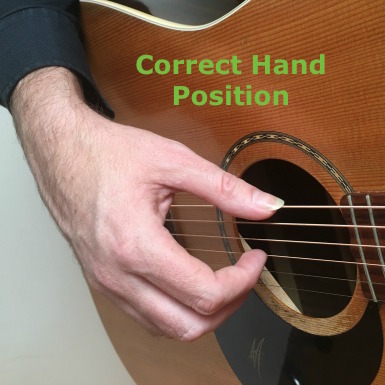
If you don't change this when fingerpicking, then your fingers will also be at about a 45 degree angle to the strings. This does not allow enough leverage for your fingers to pluck the strings properly and will result in bad fingerpicking technique. Try it and you'll see what I mean.
Instead, your fingers need to be at more of a 90 degree angle to the strings. This way you will be able to generate more power when plucking them. To do this simply raise the wrist of your picking hand to be higher above the strings from where it normally would be when using a plectrum. This will put your fingers at the correct angle to the strings.
If you do not have your hand at the this angle to the strings then it will cause many problems in your guitar fingerpicking technique. This is absolutely essential to get right if you are to have a good foundation to base this style of playing upon.
And finally:
If you have mostly played your acoustic with a plectrum, then you will use to moving your wrist and arm as you play. When fingerpicking your guitar your arm and wrist mostly stay still. All the movement is generated from the fingers themselves that are plucking the strings.
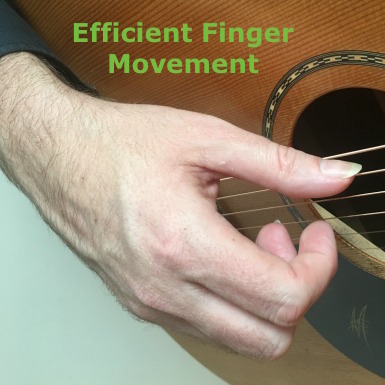
Resist the urge to pull away as you pluck each string with your fingers.
Here is an E7 chord vamp from the video that accompanies this article, for you to hone your new found fingerpicking skills:

When playing this example, rotate your focus on each key area of our fingerpicking technique we have covered.
So play it several times and focus on:
Start from the foundation we have set up earlier in the article with specific fingers assigned to specific strings. In this example, as is often the case, there is no need to deviate from this.
Play it several more times and focus on:
Are your fingers at more or less of a 90 degree angle to the strings? Is your wrist raised up above the strings as oppose to how it is when flat picking?
Continue playing the example above and focus on:
Make sure movement is isolated to your fingers with your arm and wrist kept still.
Train your fingerpicking by rotating your focus across these 3 key areas and you will be on your way to a great fingerpicking guitar technique!
Check out these three guitar fingerpicking patterns that are advanced sounding but easy to play and continue to reinforce great fingerpicking technique.
Specializing in online acoustic guitar lessons, Simon Candy is based in Melbourne, Australia where he runs his own guitar school.